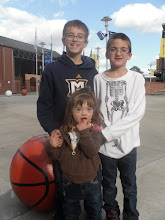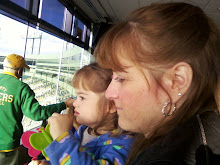In the Short Bus (Jonathan Mooney), the author notes that Down syndrome has been present throughout human history and has also been reported to exist in our closest primate relatives. Societies vary in how they view individuals with Down syndrome, from acceptance to rejection. In the United States, the average life span of children with Down syndrome was two years in 1968; in 1997 the average life span shot up fifty-years because of medical treatment. In the 1970s doctors often suggested that families institutionalize children with Down syndrome because of misconceptions about their ability to bond, learn, and develop. All of this speaks loudly to our history in the rejection of individuals with cognitive disabilities. Hopefully our society will continue be different in many respects as my Quinn ages.
Mooney provides some history about the term Down syndrome in his book. Down syndrome is named after a British physician, John Langdon Down (1828-1896). Down was appointed Medical Superintendent to the Earlswood Asylum for Idiots in 1958. He was horrified by the conditions he saw there and in other institutions and was driven to improve conditions. Many were surprised that he selected to work in this field, given the social stigma of this population at this time. In addition to working to improve conditions for individuals with cognitive disabilities placed in institutions, he also supported higher education for women. On the negative side, his paper “Observations of the Ethnic Classification of Idiots” theorized that different conditions could be classified by ethnic characteristics, and individuals with Down syndrome became referred to as “Mongoliods” because of some of their physical features. Mooney gives the following account of some of Down’s beliefs: “The title of his breakthrough paper on what would become known as Down syndrome was ‘Mongolian Type of Idiocy.’ His theory can be paraphrased as follows: Mental deficiency in white kids is a form of arrested evolutionary development. Down had all sorts of classification systems based on a hierarchical evolutionary ladder, but the one that made him famous was ‘Mongolism idiocy’” (p. 186). Another concern Mooney had about Down’s work was that his description of individuals with Down syndrome was infantilizing. This is not to say that he didn’t have compassion and caring for those he worked with, but that he saw them as “angels, perpetual children, and as almost impossibly kind” (p. 186). Mooney gives the following effect of this: “While this is better than most descriptions of people with disabilities, there was also a subtle form of dehumanization in this description of people with Down syndrome – it was as if they were in fact a different species” (p. 186). Mooney states that the most significant struggle of individuals with Down syndrome does not involve the extra chromosome, but rather how they are treated and the discrimination they experience. Maybe this relates to fear, for having a child with Down syndrome can happen to anyone, anywhere, and is something that you cannot control at the time of conception.
In his book, Mooney meets a young woman with Down syndrome named Katie Basford. I already had posted a clip from the documentary (which I believe has not been released yet). This clip shows some of Mooney’s visit with Katie, and I am reposting it below so you can meet Katie as well if you haven’t already. During his time with Katie, Mooney is tested. Although he has his own history in special education as a child, being with Katie tests many of Mooney’s beliefs and assumptions. For him, it was all about excelling and proving to others he didn’t belong in special education. With Katie, things are different. It is more about how similar she is to other girls, that she is a human and not some angel figure, and the impact she has on the lives of others. This makes him question many of his own prejudices surrounding what is ability and what is disability. This is what having someone with Down syndrome enter your life can do to you. I know because I have experienced it. Mooney states the following about Katie: “[her family] realized that she had changed, already, every single person in the family. She had made an impact on the ways that all her family members saw their lives and life itself. She changed how they looked at and thought of others. How do we value a life? Count all the fingers and toes. Look at the head and make sure it looks like every other kid’s head. Think about the brain, make sure it will work like everyone else’s. Is the value of a life just the sum of its parts?” (p. 191).
The value of life should not be just placed on how much that person can accomplish. Sometimes an individual accomplish a lot, more than anyone else, through what she teaches people just by existing and being present in their lives. This is what Quinn is doing for me. I am still struggling with this concept though. I go back to feelings of sadness thinking about her future and what she may or may not accomplish. I have to remind myself that this is not important. Jonathan Mooney’s visit with Katie reminds me of some important things – in Katie’s world, just like Quinn’s world, “there is no hierarchy of human worth” (p. 198). Isn’t that the way it should be? In addition, Quinn isn’t the one that needs to be fixed – it is all of us who need to be fixed in our perception of disabilities and diversity (p. 199). And lastly, life is about the relationships, not accomplishments. To illustrate this, I will share this account from Candee, Katie’s mother, in Mooney’s book: “Candee asked Katie what she could do to help her, to support her dreams. Katie responded, ‘You can teach me to dance.’ Candee was at a loss at first. She didn’t get it. ‘Teach you to dance? What good does that do?’ Katie smiled and said, ‘If you teach me to dance, then we can dance together.’ It wasn’t about helping Katie – it was about Katie helping us be connected. ‘I just think it’s a shame that we believe that we are individuals in the world. Someone’s presence can shape all of us,’ Candee said” (p. 200).
Quinn, let’s dance baby girl!
-Karyn
What day is it, even?
4 years ago


















No comments:
Post a Comment